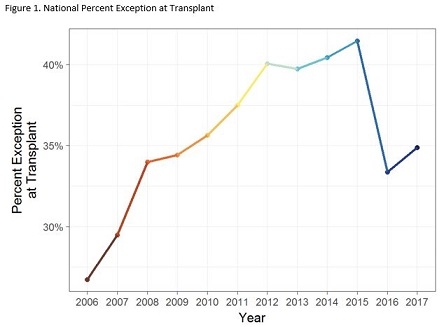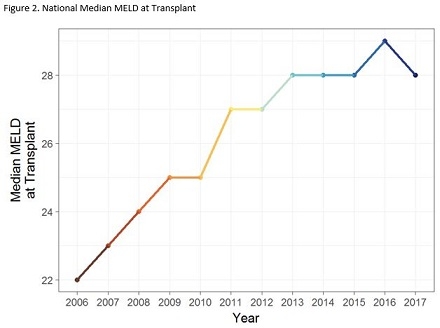Is Percent Exception at Transplant a Driver of MELD Inflation?
1SRTR, Minneapolis, MN
2Stanford University, Stanford, CA
3Univ of Minnesota, Minneapolis, MN.
Meeting: 2018 American Transplant Congress
Abstract number: A279
Keywords: Allocation, Liver, Liver transplantation, Public policy
Session Information
Session Name: Poster Session A: Liver: MELD, Allocation and Donor Issues (DCD/ECD)
Session Type: Poster Session
Date: Saturday, June 2, 2018
Session Time: 5:30pm-7:30pm
 Presentation Time: 5:30pm-7:30pm
Presentation Time: 5:30pm-7:30pm
Location: Hall 4EF
Before 2016, the proportion of deceased donor liver recipients with an exception status at liver transplant (LT) correlated strongly with median MELD at transplant (MMaT) leading to the belief that it is a major driver of MELD inflation. The recent implementation of the “cap and delay” policy in Oct 2015 for hepatocellular carcinoma (HCC) exception points provides a unique opportunity to study the hypothetical link between the proportion with exception status and MMaT.
We selected adult (18+) deceased donor liver recipients from SRTR standard analysis files (Jan 1, 2006-June 30, 2017. The proportion of LT recipients with exceptions and MMaT were calculated by year (first half of 2017). Status 1, 1A, and 1B recipients were excluded from the analysis of MMaT.
The proportion of recipients with exceptions at LT rose steadily 2006-2015, but dropped dramatically in 2016 after implementation of HCC cap and delay (Figure 1). “HCC2” exceptions made up 14.7% of LTs in 2015, 9.4% in 2016, and 8.6% in 2017. “HCC other” exceptions made up 12.4% of LTs in 2015, 11.5% in 2016, and 13.9% in 2017. In each region, the proportion with exceptions at LT was lower in 2017 than in 2015. MMaT for the entire US did not change significantly between 2013 and 2017 (Figure 2). During the same period, MMaT increased in 8 regions, remained unchanged in 1, and decreased in 2. Nationally, the proportion of LT recipients with exceptions at LT and MMaT were highly correlated (r2 = 0.947, p<0.01) in 2006-2015; however, there has been no association in the last 2 years.
In contrast to the historical association, more recent data show no association between the proportion of exception recipients and MELD inflation. Alternatively, improved pretransplant care may have contributed to recent MELD inflation.
CITATION INFORMATION: Schladt D., Snyder J., Israni A., Kim W., Lake J. Is Percent Exception at Transplant a Driver of MELD Inflation? Am J Transplant. 2017;17 (suppl 3).
To cite this abstract in AMA style:
Schladt D, Snyder J, Israni A, Kim W, Lake J. Is Percent Exception at Transplant a Driver of MELD Inflation? [abstract]. https://atcmeetingabstracts.com/abstract/is-percent-exception-at-transplant-a-driver-of-meld-inflation/. Accessed December 15, 2025.« Back to 2018 American Transplant Congress


